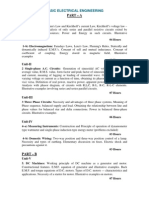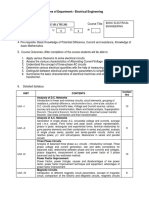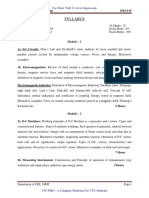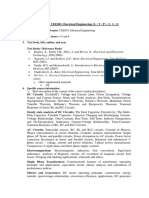ENDTC Second Year 3 Sem
ENDTC Second Year 3 Sem
Uploaded by
pravin23105921Copyright:
Available Formats
ENDTC Second Year 3 Sem
ENDTC Second Year 3 Sem
Uploaded by
pravin23105921Original Description:
Copyright
Available Formats
Share this document
Did you find this document useful?
Is this content inappropriate?
Copyright:
Available Formats
ENDTC Second Year 3 Sem
ENDTC Second Year 3 Sem
Uploaded by
pravin23105921Copyright:
Available Formats
w.e.
f Academic Year 2012-13 G Scheme
Course Name : Electronics Engineering Group.
Course Code : DE/ED/EI/EJ/EN/ET/EV/EX/IC/IE/IS/IU/MU
Semester : Third
Subject Title : Electrical Engineering
Subject Code : 17318
Teaching and Examination Scheme
Teaching Scheme Examination Scheme
PAPER
TH TU PR TH PR OR TW TOTAL
HRS
03 -- 02 03 100 -- -- 25@ 125
NOTE:
Two tests each of 25 marks to be conducted as per the schedule given by MSBTE.
Total of tests marks for all theory subjects are to be converted out of 50 and to be entered in
mark sheet under the head Sessional Work. (SW)
Rationale:
The basic concepts of electrical engineering are covered in the subject Elements of
Electronics Engineering in the second semester. Electrical Engineering subject is designed for
second year diploma course in Electronics Engineering group. The subject covers analysis of ac
networks, working principles and characteristics of various drives. The subject includes various
safety rules, methods and equipments used for system and operation. The basic concepts studied
in this subject will be very useful for understanding of Power electronics and electronic drives of
electronics course.
Objectives:
The students will be able to
1. Understand single phase and three phase AC circuits.
2. Realize concept of electromagnetic induction and apply it to static and rotating machines.
3. Understand characteristics of rotating machines.
4. Know the importance of safety and various safety methods in electrical engineering.
MSBTE - Final Copy Dt. 14/01/2013 12 17318 ETX3
w.e.f Academic Year 2012-13 G Scheme
Learning Structure:
Performance of transformer, machine, Calculate Series circuit & parallel
Applications circuit.
To solve To solve Three Operation & Operation &
Procedure Single phase phase balanced performance performance
Series circuit Circuits of Transformer of Machines
& parallel
A.C. Series Polyphase Electromagnetic induction, self &
circuit & Circuit mutually induced emf, Lenzs law,
Principle parallel circuit Faradays laws
Concept Electromagnetism, Single phase,
three phase supply system.
Facts Various parameter of electrical network, ohms law, kirchoffs law, transformer, AC
machines.
MSBTE - Final Copy Dt. 14/01/2013 13 17318 ETX3
w.e.f Academic Year 2012-13 G Scheme
Content Theory:
Topic Hours Marks
Topic 1 : AC Fundamentals
Specific Objectives :
Compare AC and DC system.
Meaning of various terms related to AC system.
Distinguish Various AC circuits and Understand rules and
procedure to draw vector diagrams for the same.
To realize concept of various resonance parameters and plot the
graph.
Contents :
Difference between A.C. and D.C. quantity
Advantages of A.C. over D.C.
waveform of sinusoidal A.C. cycle
Generation of single phase A.C. by elementary alternator
Definitions: instantaneous value, cycle, amplitude, time period,
frequency, angular frequency, R.M.S. value, Average value for
sinusoidal waveform, Form factor, Peak factor (no derivation , simple
numerical on it)
Phasor representation of sinusoidal A.C. quantity, review of phasor 14 30
algebra, representation of A.C. quantity in rectangular.
Phase angle, phase difference, concept of lagging and leading by
waveforms, mathematical equations and phasors.
Pure resistance, inductance and capacitance in A.C. circuit
waveforms, equations and phasor diagram (no derivation)
Concept of impedance and impedance triangle.
Power active, reactive and apparent, power triangle.
Power factor and its significance.
R-L, R-C and R-L-C series circuit phasor diagram, voltage and
current equations.
Simple numerical on R-L, R-C and R-L-C series circuit.
Resonance in R-L-C series circuit: Conditions for resonance, graphical
representation of resonance curve, resonant frequency, bandwidth and
Q factor of series resonant circuit.
Resonance in parallel circuit, resonant frequency and Q factor, nature
of resonance curve (No derivation &no numerical)
Topic 2: Polyphase Circuits
Specific Objectives :
Compare three phase and single phase system.
Define various terms related to three phase system.
Interpret relations between line & phase values of current, voltage,
power& power factor of star & delta connected systems.
Contents :
Advantages of 3 phase system over 1 phase system 06 12
Principle of 3-phase e.m.f. generation and its waveform
Concept of phase sequence
Balanced and unbalanced load
Relation between phase and line current, phase and line voltage in Star
connected and Delta connected balanced system. (no derivation)
Calculation of current, power, power factor in a 3 phase balanced
MSBTE - Final Copy Dt. 14/01/2013 14 17318 ETX3
w.e.f Academic Year 2012-13 G Scheme
system (simple numerical)
Topic 3 : Electromagnetic Induction
Specific Objective :
Realize the concept of self and mutually induced EMF.
Interprete Faradays laws of electromagnetic induction.
Contents :
Relation between Magnetism and Electricity.
Production of Induced E.M.F. and Current.
04 08
Faradays Laws of Electromagnetic Induction.
Flemings Right Hand Rule
Lenzs Law
Induced E.M.F: Self Induced E.M.F., Mutually Induced E.M.F.,
direction of Induced E.M.F. and Currents.
Energy Stored in Magnetic Field
(No Derivation and No Numerical)
Topic 4: Single Phase Transformer
Specific Objective :
Draw construction diagram and explain working principle of
single phase transformer.
Interprete the relationship between various parameters of
transformers.
Compare autotransformer & two winding transformer
Contents :
Construction and working of transformer, classification , brief
description of each part, its function
(power transformer, audio frequency transformer, radio 06 16
frequency transformer, isolating transformer, pulse
transformer, intermediate frequency transformer)
Significance of Emf equation (no derivation)
Voltage ratio, current ratio and transformation ratio.
KVA rating of a transformer
Losses in a transformer
% efficiency & % regulation
Auto transformer comparison with two winding transformer,
Applications
Simple numerical on this topic
Topic : 5 : Three Phase Induction Motor
Specific Objectives :
Realize construction principle of working & types of three phase
induction motor.
Identify speed torque characteristics.
Use of variations in voltage, current and frequency for speed
control of motors.
Contents: 08 16
Construction and principle of working
Types Squirrel cage and slip ring
Synchronous speed, slip speed, slip and rotor frequency (no numerical)
Torque speed characteristics
Necessity of starter
Basic concepts of speed control method using thyristor.
MSBTE - Final Copy Dt. 14/01/2013 15 17318 ETX3
w.e.f Academic Year 2012-13 G Scheme
Revesal of rotation of 3 phase induction motor.
Topic : 6 Fractional Horse Power Motors
Specific Objectives :
Draw Schematic representation, Principle of working ,
characteristics and applications of
i) Single Phase Induction Motor
ii) Universal Motor
iii) Stepper Motor
iv) Servo Motor
Contents : 08 12
Schematic representation, principle of operation and applications of the
Split phase single phase induction motors.
Universal motor - Schematic representation principle of operation,
reversal of rotation and applications
Stepper motor - Schematic representation types, principle of working
and applications
Servo motor - Schematic representation types, principle of working
and applications
Topic 7 : Electrical Safety
Specific Objectives :
Understand and reproduce use of safety equipments
Contents :
Study of different accessories like MCCB, ELCB, cables and wires
02 06
used in domestic and commercial electrical wiring.
Use of megger as earth tester.(front panel diagram & different control
terminals)
Necessity of earthing and list its types.
Electrical safety
Total 48 100
Practical:
Skills to be developed:
Intellectual Skills:
1. Identify various types of Machines.
2. Select Instruments and their ranges.
Motor Skills:
1. Draw machine characteristics.
2. Make proper connection.
3. Accuracy in measurements.
List of Practicals:
1. Know your electrical laboratory.
2. Determine the resistance, inductance and impedance of choke coil by observing its
response to A. C. and D. C supply.
3. Draw the phasor diagram and determine the power factor of R-L-C series circuit.
MSBTE - Final Copy Dt. 14/01/2013 16 17318 ETX3
w.e.f Academic Year 2012-13 G Scheme
4. Verify the relationship between line and phase values of voltages and currents in three
phase balanced star and delta connected load.
5. Identify the type of transformer based on the transformation ration of single phase
transformer.
6. Determine Efficiency and single phase transformer at no load, half load and full load by
conducting load test.
7. Determination of slip of three phase induction Motor by tachometer method and
observation of variation in speed to change in supply voltage.
8. Reversal of direction of rotation of single phase induction motor.
9. Measurement of insulation resistance using megger.
10. Study of different types of Cables and switches.
11. Mini project which includes connection of switch, holder, plug socket, fuse and indicator.
Learning Resources:
Books:
Sr.
Author Title Publisher
No
Electrical & Electronics
1 Hughes Pearson
Technology
Tata McGraw Hill, New
2 Mittle & Mittal Basic Electrical Engineering
Delhi
Electrical Technology Vol- I & S.Chand Publications
3 B.L. Theraja
II Delhi
V. K. Mehta, Rohit S.Chand Publications
4 Basic Electrical Engineering
Mehta Delhi
Websites: www.housestuff.com
MSBTE - Final Copy Dt. 14/01/2013 17 17318 ETX3
You might also like
- DAX Power Pivot Time IntelligenceDocument134 pagesDAX Power Pivot Time IntelligenceLupi Dobrić100% (1)
- Theories of ProfitDocument6 pagesTheories of Profitvinati100% (1)
- Chap 05 Real Analysis: Function of Several VariablesDocument39 pagesChap 05 Real Analysis: Function of Several Variablesatiq4pk100% (4)
- Course 2. Basic Electrical Technology (Video Course) Faculty Coordinator(s) : 1Document32 pagesCourse 2. Basic Electrical Technology (Video Course) Faculty Coordinator(s) : 1Ursap BuddyNo ratings yet
- ES103Document3 pagesES103Sualé SualéNo ratings yet
- Basic Electrical EngineeringDocument2 pagesBasic Electrical Engineeringmadhu322No ratings yet
- Electrical SyllabusDocument2 pagesElectrical Syllabusharsh dubeyNo ratings yet
- Syllabus For ElectDocument30 pagesSyllabus For Elects MishraNo ratings yet
- Sy 58Document35 pagesSy 58Dev SinghNo ratings yet
- Syllabus KEE101TDocument1 pageSyllabus KEE101TDr. Abhishek MishraNo ratings yet
- Syllabus For Basic Electrical 2018-19Document2 pagesSyllabus For Basic Electrical 2018-19iamrichtraderNo ratings yet
- 11o205 Basics of Electrical and Electronics EngineeringDocument4 pages11o205 Basics of Electrical and Electronics EngineeringImranNo ratings yet
- Automobile Sem 5Document7 pagesAutomobile Sem 5pravin23105921No ratings yet
- EE258 2024 CoursePlan - SubjectedToDUGCapprovalDocument3 pagesEE258 2024 CoursePlan - SubjectedToDUGCapprovalSumukha ShettyNo ratings yet
- Ma205 Transforms and Partial Differential Equations: L T P CDocument8 pagesMa205 Transforms and Partial Differential Equations: L T P CArjun PrasadNo ratings yet
- Module 4 TransformersDocument23 pagesModule 4 TransformersvijayNo ratings yet
- ElectricalDocument36 pagesElectricaljohnpaul988488No ratings yet
- SyllabusDocument2 pagesSyllabuskingmad106No ratings yet
- Ee001 Power Generation Systems: L T P CDocument32 pagesEe001 Power Generation Systems: L T P CPARTH DAVENo ratings yet
- Rec SemiDocument20 pagesRec SeminadirNo ratings yet
- PDFDocument4 pagesPDFRishiNo ratings yet
- Electrical Machines & Measurement B.E. 4 SemesterDocument4 pagesElectrical Machines & Measurement B.E. 4 Semestersameerpatel15770No ratings yet
- Introduction To Electrical Engineering: Course DescriptionDocument3 pagesIntroduction To Electrical Engineering: Course Descriptionnavneetkpatil8409No ratings yet
- AKU Patna Syllabus 3rd YearDocument20 pagesAKU Patna Syllabus 3rd Yearडाँ सूर्यदेव चौधरीNo ratings yet
- Name of Department:-Electrical EngineeringDocument2 pagesName of Department:-Electrical EngineeringAnonymous HyOfbJ6No ratings yet
- Ma205 Transforms and Partial Differential Equations: L T P CDocument8 pagesMa205 Transforms and Partial Differential Equations: L T P CBharathwaj SreedharNo ratings yet
- SYLLABUSDocument2 pagesSYLLABUSNithin KumarNo ratings yet
- Basic Electricals Engg. 15ele15 Notes PDFDocument135 pagesBasic Electricals Engg. 15ele15 Notes PDFAbhay KumarNo ratings yet
- Basic Electrical EngineeringDocument110 pagesBasic Electrical Engineeringmusic kalakarNo ratings yet
- N5ac36742044edll BookDocument27 pagesN5ac36742044edll Bookprtz.idNo ratings yet
- EE SyllabusDocument95 pagesEE Syllabusvikram patilNo ratings yet
- Ece1002 Fundamentals-Of-Electrical-And-Electronics-Engineering Ela 2.0 5 Ece1002 Feee 2.0Document3 pagesEce1002 Fundamentals-Of-Electrical-And-Electronics-Engineering Ela 2.0 5 Ece1002 Feee 2.0gorijavolukaveri18No ratings yet
- BEE SyllabusDocument2 pagesBEE SyllabusKondeti Venkata AbhinavaNo ratings yet
- Basic Electrical Engineering (14ele15-14ele25)Document3 pagesBasic Electrical Engineering (14ele15-14ele25)Swati MuttuNo ratings yet
- SyllabusDocument5 pagesSyllabusjijo123408No ratings yet
- DC Machine and TransformerDocument4 pagesDC Machine and TransformermitulNo ratings yet
- 1st Year Syllabus 2018 19Document89 pages1st Year Syllabus 2018 19Abhishek GargNo ratings yet
- National Institute of Technology, Srinagar Electrical EngineeringDocument33 pagesNational Institute of Technology, Srinagar Electrical Engineeringzahir khNo ratings yet
- BEEE SyllabusDocument2 pagesBEEE Syllabushard.worker123hwNo ratings yet
- SEM1Document26 pagesSEM1Soham JoitaNo ratings yet
- Mod 1Document151 pagesMod 1ashokhansda777No ratings yet
- Bput 2-4 Yr It SyllabusDocument45 pagesBput 2-4 Yr It SyllabusSankarsan SahooNo ratings yet
- Eee I Basic Electricals Engg. 15ele15 NotesDocument135 pagesEee I Basic Electricals Engg. 15ele15 NotesOmeshwarNo ratings yet
- Nit 3Document11 pagesNit 3Er Paramjit SinghNo ratings yet
- Basic Ele Engg PDFDocument198 pagesBasic Ele Engg PDFVarsha KondabattulaNo ratings yet
- Bee Cse Course FileDocument12 pagesBee Cse Course FileJulie OsborneNo ratings yet
- Chhattisgarh Swami Vivekanand Technical University, Bhilai: Total Period 08Document19 pagesChhattisgarh Swami Vivekanand Technical University, Bhilai: Total Period 08Piyush KumarNo ratings yet
- Fundamentals of Electrical & Electronics EngineeringDocument4 pagesFundamentals of Electrical & Electronics Engineeringandruz1896No ratings yet
- B. E. Sem Vi (Electrical) E-601: Electrical Machines - IiiDocument10 pagesB. E. Sem Vi (Electrical) E-601: Electrical Machines - IiibaruaeeeNo ratings yet
- III and IV Sem EE SyllabusDocument33 pagesIII and IV Sem EE Syllabusa07459478No ratings yet
- Basic Electrical Engineering - OrganizedDocument109 pagesBasic Electrical Engineering - Organizedrudra1234749384No ratings yet
- UEE001 SyllabusDocument2 pagesUEE001 SyllabusashNo ratings yet
- 3rd-4th Semester Detailed Syllabus - EEDocument30 pages3rd-4th Semester Detailed Syllabus - EESAUMYAJIT SABUINo ratings yet
- EE26105 Elements of Electrical EngineeringDocument2 pagesEE26105 Elements of Electrical Engineeringkeshav kumarNo ratings yet
- CC CT CT Ha ha102-N-BASIC ELECTRICAL & ELECTRONICS ENGINEERINGDocument4 pagesCC CT CT Ha ha102-N-BASIC ELECTRICAL & ELECTRONICS ENGINEERINGtakshbhavsar1797No ratings yet
- 21 Ele 13Document3 pages21 Ele 13c rajNo ratings yet
- 3.1 Fundamentals of Electrical EngineeringDocument20 pages3.1 Fundamentals of Electrical EngineeringmadhurithaNo ratings yet
- Ma202 Numerical Methods: L T P CDocument8 pagesMa202 Numerical Methods: L T P CVIGNESH L RNo ratings yet
- EE1101Document2 pagesEE1101balajiNo ratings yet
- Guru Tegh Bahadur Institute of TechnologyDocument3 pagesGuru Tegh Bahadur Institute of TechnologyVishal143dsNo ratings yet
- Guru Tegh Bahadur Institute of TechnologyDocument3 pagesGuru Tegh Bahadur Institute of TechnologyAnonymous tYzIdURQONo ratings yet
- Concepts of EEE (CS)Document8 pagesConcepts of EEE (CS)Vikram RaoNo ratings yet
- ARM Core Data Flow ModelDocument6 pagesARM Core Data Flow Modelpravin23105921No ratings yet
- Software Lifecycle ModelsDocument20 pagesSoftware Lifecycle Modelspravin23105921No ratings yet
- ME Old NewDocument1,031 pagesME Old Newpravin23105921No ratings yet
- 3865 Question PaperDocument986 pages3865 Question PaperKunal RanjaneNo ratings yet
- Print LabelsDocument6 pagesPrint Labelspravin23105921No ratings yet
- Print LABELSDocument6 pagesPrint LABELSpravin23105921No ratings yet
- Final Black BookDocument39 pagesFinal Black Bookpravin23105921No ratings yet
- Automobile Sem 5Document7 pagesAutomobile Sem 5pravin23105921No ratings yet
- Ict AssignmentDocument3 pagesIct Assignment123vidyaNo ratings yet
- Boundary Value Problems in One DimensionDocument63 pagesBoundary Value Problems in One DimensionSudipNo ratings yet
- Topic: Operator Precedence Parsing (3 Sep)Document3 pagesTopic: Operator Precedence Parsing (3 Sep)brbfetrNo ratings yet
- Dalgaard 1994Document14 pagesDalgaard 1994tri hastutiNo ratings yet
- NE 304: Introduction To Nuclear Engineering: Topic:Equation of ContinuityDocument29 pagesNE 304: Introduction To Nuclear Engineering: Topic:Equation of ContinuityMaher1420No ratings yet
- KT Structured Problem SolvingDocument28 pagesKT Structured Problem Solvingprincekamutikanjore100% (1)
- Elastic-Plastic Fracture Mechanics For Initiation and Propagation of Notch Fatigue CracksDocument16 pagesElastic-Plastic Fracture Mechanics For Initiation and Propagation of Notch Fatigue CracksLight HouseNo ratings yet
- Hydrostatic Forces On SurfacesDocument28 pagesHydrostatic Forces On SurfacesKarla Buenaflor100% (1)
- Basic Electrical Engineering Theory 2020-21Document177 pagesBasic Electrical Engineering Theory 2020-21Mohit PatilNo ratings yet
- Immediate Download (Ebook PDF) Applied Calculus For The Managerial, Life, and Social Sciences: A Brief Approach 10th Edition Ebooks 2024Document49 pagesImmediate Download (Ebook PDF) Applied Calculus For The Managerial, Life, and Social Sciences: A Brief Approach 10th Edition Ebooks 2024meddahiberra100% (5)
- Stochastics NotesDocument19 pagesStochastics Notesvishalmundhe494No ratings yet
- Subject Verb Agreement Class 10Document15 pagesSubject Verb Agreement Class 10Rhythm MishraNo ratings yet
- Irjet V6i4748 PDFDocument6 pagesIrjet V6i4748 PDFsumit sharmaNo ratings yet
- Report On Project 1 Speech Emotion RecognitionDocument10 pagesReport On Project 1 Speech Emotion Recognitionarchana kumariNo ratings yet
- Leeman Coding Theory 1Document3 pagesLeeman Coding Theory 1bugraNo ratings yet
- Assignment ProbabilityDocument6 pagesAssignment ProbabilityVarun LalwaniNo ratings yet
- Unit Assesment MapDocument3 pagesUnit Assesment MapYuri IssangNo ratings yet
- Moisture Content ReportDocument2 pagesMoisture Content ReportAmrish Zaidi50% (4)
- P2 - Ch4 - Cheat SheetDocument1 pageP2 - Ch4 - Cheat SheetLing Chi, Daniel LUKNo ratings yet
- 0-9 Decoder DisplayDocument9 pages0-9 Decoder DisplayRazel Kaye MahinayNo ratings yet
- DOE-Assignment 2 (Teddy)Document25 pagesDOE-Assignment 2 (Teddy)Tewodros BirhanNo ratings yet
- Experience Guide Quarter 1 - Math 10 Lesson 2: Factoring TrinomialsDocument5 pagesExperience Guide Quarter 1 - Math 10 Lesson 2: Factoring TrinomialsRanen Darren P. BenitoNo ratings yet
- CSE 231L Lab Report 1Document23 pagesCSE 231L Lab Report 1Rayhan Amin 2212830042No ratings yet
- Ch1 Test Bank HandoutDocument8 pagesCh1 Test Bank HandoutAndrew Tandoh100% (1)
- Python Exercises-Conditional StatementsDocument2 pagesPython Exercises-Conditional Statementsananya.jannareddiNo ratings yet
- Unit # 3 Basics of Digital Cmos Design: Chapter 1: Combinational Mos Logic CircuitsDocument67 pagesUnit # 3 Basics of Digital Cmos Design: Chapter 1: Combinational Mos Logic CircuitsPunith Gowda M B50% (2)
- (PD ISO GUIDE 33) - Reference Materials. Good Practice in Using Reference MaterialsDocument45 pages(PD ISO GUIDE 33) - Reference Materials. Good Practice in Using Reference MaterialsboncherryerlyNo ratings yet
































































































